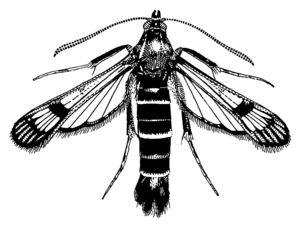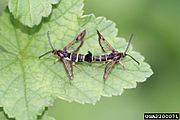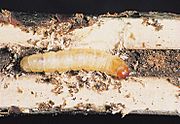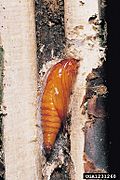Synanthedon tipuliformis facts for kids
Quick facts for kids Synanthedon tipuliformis |
|
|---|---|
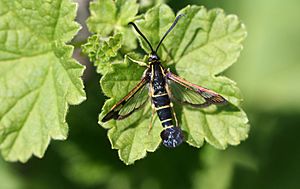 |
|
| Scientific classification | |
| Synonyms | |
|
The currant clearwing (scientific name: Synanthedon tipuliformis) is a type of moth. It belongs to a group of moths called Sesiidae. These moths are special because their wings are often clear, like a window!
This moth originally lived in parts of Europe and Asia. But over time, it has traveled to new places. Now, you can also find it in North America, Australia, and New Zealand. In these new places, it is known as an invasive species. This means it has moved into an area where it doesn't naturally belong.
Contents
About the Currant Clearwing Moth
The currant clearwing moth is quite small. Its wingspan is usually about 17 to 20 millimeters wide. That's less than an inch! These moths are active during the warmer months. You can often see them flying from April to July. The exact time depends on where they live in the world.
What Do Currant Clearwing Moths Eat?
The young moths, called larvae or caterpillars, love to eat plants from the Ribes family. This family includes many plants that grow tasty fruits. Some of their favorite foods are:
- Blackcurrant plants
- Redcurrant plants
- Gooseberry plants (Ribes uva-crispa)
These caterpillars are quite clever. They don't just munch on the leaves. Instead, they bore (drill) into the stems of the plants. They live and feed inside the stems. This can sometimes harm the plant.
Life Cycle of the Currant Clearwing Moth
Like many insects, the currant clearwing moth goes through different stages. This is called a life cycle. It starts as an egg, then becomes a caterpillar, then a pupa, and finally, an adult moth.
From Egg to Adult Moth
- Eggs: The adult female moth lays tiny eggs on the currant or gooseberry plants.
- Caterpillar (Larva): When the eggs hatch, small caterpillars emerge. These are the larvae that bore into the plant stems. They spend their time eating and growing inside the stems.
- Pupa: After growing enough, the caterpillar changes into a pupa. This is a resting stage. Inside the pupa, the caterpillar transforms into an adult moth.
- Adult Moth: Finally, the adult moth comes out of the pupa. These adults will then find a mate and lay their own eggs. This starts the whole cycle again!


